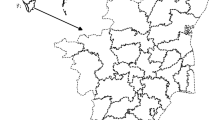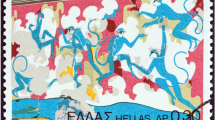Abstract
Bronze Age Aegean (ca. 3500–1100 B.C.) wall paintings from the islands of Crete and Thera depict monkeys in a variety of roles such as running wild in nature, possibly following (trained) commands, and participating in sacred activities. These images, while stylistically Aegean, are traditionally considered closely related to—and descendant from—Egyptian, Near Eastern, and Mesopotamian monkey imagery. While monkey depictions in the latter regions may provide species-specific characteristics, Aegean wall paintings typically lack this level of detail. In an attempt to better understand the relationships between the monkeys depicted in Aegean wall paintings and the species that were encountered by the Aegean, Mesopotamian, and Egyptian peoples, a collaborative team of primatologists, a taxonomic illustrator, and an art historian/archaeologist identified species-indicative visual characteristics. This collaborative approach led us to identify a new region that serves as a source for monkey iconography: the Indus River Valley. With an emphasis on the primatological aspect and the growing corpus of possible Indus goods and possible species found in the Aegean, a broader iconographic and socioreligious sphere of interaction emerges. In this expanded system, Mesopotamia functions as an intermediary that enables the movement of goods, raw materials, people, and iconography between the east and west. Mesopotamia may have even afforded an opportunity for Aegean peoples to encounter the creatures themselves, first-hand. Of primary importance to the methodology employed for this project is the cooperation of scholars from disparate disciplines—the stitching together of various projects and experiences in attempt to answer both new and previously unanswerable questions. This type of interdisciplinary approach can be applied to other species, sites, paintings, and objects to hone our understanding of period, place, animal, movement, and trade.

Image granted from the photo archive of Thera Akrotiri Excavations

Image granted from the photo archive of Thera Akrotiri Excavations

Adapted from Google Earth

Adapted from Klebs (1915), 34, Fig. 21

Adapted from Robins (2008), Fig. 218

Image courtesy of Marie N. Pareja



Adapted from Pareja (2017: 54), Fig. 5.1

Adapted from CMS III 357


Adapted from British Museum Object number 115418
Similar content being viewed by others
References
Amiet P (1988) Antiquities of Bactria and outer Iran in the Louvre collection. In: Ligabue G, Savatori S (eds) Bactria: an ancient oasis civilization from the sands of Afghanistan, pp 157–180. Venice, Centro Studi Ricerche Ligabue
Aruz J (ed) (2003) Art of the first cities: the third millennium B.C. from the Mediterranean to the Indus, New Haven, Yale University Press
Aruz J (ed) (2008) Marks of distinction. Seals and cultural exchange between the Aegean and the Orient (ca. 2600–1360 B.C.), Mainz am Rhein, Philipp von Zabern
Ashalakshmi NC, Chetan Nag KS, Praveen Karanth K (2014) Molecules support morphology: species status of South Indian populations of the widely distributed Hanuman Langur. Conserv Genet 16:43–58
Bernstein PL, Smith WJ, Krensky A, Rosene K (1978) Tail positions of Cercopithecus aethiops. Ethology 46(3):268–278
Bintliff J, Sbonias K (eds) (1999) Reconstructing past population trends in Mediterranean Europe (3000 B.C.–A.D. 1800). Oxbow Books, Oxford
Blakolmer F (2017) Deities above animals. On the transformation of Near Eastern iconography in Minoan Crete. In: Proceedings of the 12th International Cretological Congress, Irakleio
Boehmer R (1974) Das Rollsiegel in prädynastischen Ägypten. Archäol Anzeiger 89:495–514
Boochs W (1982) Siegel und Siegeln im Alten Ägypten, Sankt Augustin, H. Richarz
Chakrabarti DK (1993) ‘Long-barrel cylinder’ beads and the issue of Pre-Sargonic contact between the Harappan civilization and Mesopotamia. In: Possehl G (ed). IBH Publishing Company, Oxford, pp 265–270
Chapin A, Pareja MN (2019) Peacock or Poppycock? Investigations into Exotic Animal Imagery in Minoan and Cycladic art. In: Davis B, Laffineur R (eds) ΝΕΩΤΕΡΟΣ: studies in Bronze Age Aegean Art and Archaeology in Honor of Professor John G. Younger on the Occasion of his Retirement (Aegaeum 44)
Cheten Nag KS, Pramond P, Praveen Karanath K (2011) Taxonomic Implications of a field study of Morphotypes of Hanuman Langurs (Semnopithecus entellus) in Peninsular India. Int J Primatol 32:830–848
Cline EH (1994) Sailing the wine-dark sea. Tempus Reparatum Archaeological and Historical Associates Limited, Oxford
Cline EH (2013) Aegean-Near East relations in the second millennium B.C. In: Aruz J, Graff SB, Rakic Y (eds) Cultures in contact from Mesopotamia to the Mediterranean in the second millennium B.C., pp 26–33. Yale University Press, New Haven
Colburn CS (2008) Exotica and the early Minoan Elite: eastern imports in prepalatial Crete. Am J Archaeol 112:203–224
Cooper JS (1983) The curse of the Agade. Johns Hopkins University Press, Baltimore
Davaras C (2003) Parallels and affinities between Crete and India in the Bronze Age: some speculations. A.M. Hakkert, Amsterdam
Davaras C (2005) Bronze Age Crete and India. Indian Hist Rev 32:126–139
Davaras C, Soles J (1997) A new oriental cylinder seal from Mochlos. Appendix: catalogue of the cylinder seals found in the Aegean. ArchEph 134:29–66
de Jong YA, Butynski TM (2010) Three Sykes’s monkey Cercopithecus mitis × Vervet Monkey Chlorocebus pygerythrus hybrids in Kenya. Primate Conserv 25:43–56
Doumas C (1992) The wall paintings of Thera, Athens. The Thera Foundation-Petros M, Nomikos
Dubcová V (2015) The Near Eastern ‘Hero’ and ‘Bull-Man’ and their impact on the Aegean Bronze Age Iconography. In: Mynárová J, Onderka P, Pavúk P (eds) There and back again—the crossroads II. Proceedings of an international conference held in Prague, pp 221–244
Dunham S (1985) The monkey in the middle. Zeitschrift Assyriol Vorderasiatische Archäol 75(2):234–264
Enault J-F (1979) Fouilles de Pirak. In: Fouilles du Pakistan 2, Paris, Diffusion De Boccard
Fischer E (2019) Minoans in Punt: An Interpretation of the Akrotiri Frescoes. In: Presentation at the Archaeological Institute of America Annual Meeting in San Diego
Greenlaw C (2011) The representation of monkeys in the art and thought of Mediterranean cultures: a new perspective on ancient primates. British Archaeological Reports, Oxford
Harper PO, Aruz J, Tallon F (eds) (1992) The Royal City of Susa. In: Ancient Near Eastern Treasures in the Louvre, New York, Harry N. Abrams, Inc
Karetsou A (2000) Κρήτη-Αίγυπτος: πολιτισμικοί δεσμοί τριών χιλιετιών, καταλογος, Athens
Kenoyer JM (1997) Trade and technology of the Indus Valley: new insights from Harappa, Pakistan. World Archaeol 29:262–280
Kenoyer JM (2008) Indus and Mesopotamian trade networks: New insight from shell and carnelian artifacts. In: Olijdam E, Spoor RH (eds) Intercultural relations between South and Southwest Asia. Studies in commemoration of E.C.L. During-Caspers 1934–1996, pp 19–28. Oxford, Archaeopress
Klebs L (1915) Die Reliefs des alten Reiches (2900-2475 v. Chr): Material zur Agyptischen Kulturgeschichte, Heidelberg, Winter
Kohl PL (2007) The making of Bronze Age Eurasia. Cambridge University Press, Cambridge
Mackay EJH (1943) Chanhu-daro Excavations 1935–1936. In: American Oriental Series 20, Varanasi, Bharatiya Pub. House
Mallowan MEL (1966) Nimrud and its remains. Collins, London
Marinatos N (1984) Art and religion in Thera: reconstructing a Bronze Age society, Athens, I. Mathioulakis & Co
Matthäus H (2000) Crete and the Near East during the early 2nd Millennium B.C.-new investigations on bronze finds from the Idaean Cave of Zeus. In: Karetsou A (ed) Proceedings of the 8th International Cretological Congress, Herakleion, pp 267–280
Mendleson C (1983) More monkey business. Anatolian Stud 33:81–83
Moorey PRS (1987) On tracking cultural transfers in prehistory: the case of Egypt and lower Mesopotamia in the fourth millennium B.C. In: Rowlands M, Larsen M, Krisitiansen K (eds) Centre and periphery in the ancient world, pp 36–56. Cambridge University Press, New York
Morgan L (1997) Power of the beast: human-animal symbolism in Egyptian and Aegean art. Ägypten Levante 7:17–31
Oppenheimer JR (1977) Presbytis entellus, the Hanuman langur. Primate Conserv 1977:469–512
Pareja MN (2017) Monkey and ape iconography in Aegean Art. Uppsala, Uppsala
Pareja MN (2020) Early Bronze Age evidence for possible Aegean-Indus Trade. In: Animal Iconography in the Archaeological Record: New Approaches, New Dimensions, eds. Laerke Recht and Katarzyna Zeman-Wisniewska, Equinox Publishing
Parker P (1997) African vervets on Crete and Thera during MM IIIB-LM IA. Am J Archaeol 101:348
Pendlebury JDS (1939) The archaeology of Crete: an introduction. Methuen, London
Phillips JS (1991) The impact and implications of the Egyptian and Egyptianizing material found in Bronze Age Crete ca. 3000-ca. 1100 B.C., Ph.D. Dissertation, University of Toronto
Phillips JS (2008) Aegyptiaca on the Island of Crete in their chronological context: a critical review I. Austrian Academy of Sciences Press, Wien
Pittman H (1984) Art of the Bronze Age: Southeastern Iran, Western Central Asia, and the Indus Valley. The Metropolitan Museum of Art, New York
Podzorski P (1988) Predynastic Egyptian seals of known provenience in the R.H. Lowie Museum of Anthropologie. J Near Eastern Stud 47:259–268
Ratnagar S (2004) Trading encounters: from the Euphrates to the indus in the Bronze Age. Oxford University Press, New Delhi
Roaf M (2004) Cultural Atlas of Mesopotamia and the Near East. Oxford University Press, Oxford
Robins G (2008) The art of ancient Egypt. Harvard University Press, Cambridge
Rowe N (1996) Pictorial guide to the living primates. Pogonias Press
Rowe N, Myers M (eds) (2016) All the World’s primates. Pogonias Press
Sarianidi VI (1998) Myths of ancient Bactria and Margiana on its seals and amulets, Moscow
Sarianidi VI, Kowalski LH (1971) The Lapis lazuli route in the ancient Near East. Archaeology 24:12–15
Scharff A (1931) Die Altertümer der Vor- und Frühzeit Ägyptens. K. Curtius, Berlin
Shinde V, Deshpande SS, Osada T, Uno T (2006) Basic issues in harappan archaeology: some thoughts. Ancient Asia 1:63–72
Soles JS (2016) Hero, Goddess, Priestess: New Evidence for Minoan Religion and Social Organization. In: Alram-Stern E, Blakolmer F, Deger-Jalkotzy S, Laffineur R, Weilhartner J (eds) METAPHYSIS. Ritual, Myth, and Symbolism in the Aegean Bronze Age. Proceedings of the 15th International Aegean Conference, Vienna, Institute for Oriental and European Archaeology, Aegean and Anatolia Department, Austrian Academy of Sciences and Institute of Classical Archaeology, University of Vienna, pp 247–252, Liége, Peeters
Strasser T (1997) The blue monkeys of the Aegean and their implications for Bronze Age trade. Am J Archaeol 101:348
Van Buren ED (1939) The Fauna of ancient Mesopotamia as represented in art. Pontificum institutum biblicum, Rome
Warren, P.M. (1974). “Crete, 3000-1400 B.C.: Immigration and the Archaeological Evidence,” in R.A. Crossland and A. Birchall (eds.), Bronze Age Migrations in the Aegean: Archaeological and Linguistic Problems in Greek Prehistory, 41-50. Park Ridge, Noyes Press
Weeks L (1999) Lead isotope analysis from Tell Abraq, United Arab Emirates: New data regarding the ‘tin problem’ in Western Asia. Antiquity 73:2–7
Wiener MH (2013) Contacts: Crete, Egypt, and the Near East circa 2000 B.C. In: Aruz J, Graff SB, Rakic Y (eds) Cultures in contact from Mesopotamia to the Mediterranean in the Second Millennium B.C., pp 34–43. Yale University Press, New Haven
Wilkinson TC (2014) Tying the threads of Eurasia: trans-regional routes and material flows in Transcaucasia, eastern Anatolia and western central Asia, c. 3000–1500 BC, Leiden, Sidestone Press
Yule P (1980) Early Cretan seals: a study of chronology (Marburger Studien zur Vor-und Frühgeschichte 4), Mainz am Rhein, von Zabern
Zervos C (1956) L’Art de la Crete: Neolithique et Minoenne, Paris, Éditions “Cahiers d’art”
Acknowledgements
The authors extend their gratitude to the Archaeological Institute of America (AIA) and the Ancient Painting Studies Interest Group (APSIG) for the opportunity to present the preliminary results of this study. Marie Pareja personally thanks Tristan Carter, Anne P. Chapin, Tiffany L. Hunt, Leanna Kolonauski, and Kristine Mallinson for their thoughts, edits, and enthusiasm for this project. Illustrations copyright 2019 Stephen D. Nash/IUCN SSC Primate Specialist Group.
Author information
Authors and Affiliations
Corresponding author
Ethics declarations
Conflict of interest
The authors declare that they have no conflict of interest.
Ethical approval
This article does not contain any studies with human participants or animals performed by any of the authors.
Additional information
Publisher's Note
Springer Nature remains neutral with regard to jurisdictional claims in published maps and institutional affiliations.
About this article
Cite this article
Pareja, M.N., McKinney, T., Mayhew, J.A. et al. A new identification of the monkeys depicted in a Bronze Age wall painting from Akrotiri, Thera. Primates 61, 159–168 (2020). https://doi.org/10.1007/s10329-019-00778-1
Received:
Accepted:
Published:
Issue Date:
DOI: https://doi.org/10.1007/s10329-019-00778-1




